Reviewing Literature in Art and Design
VerifiedAdded on 2023/06/03
|7
|1882
|167
AI Summary
This annotated bibliography discusses the impact of design on socially responsible behavior, happiness, user experience innovation, emotion, and material experience. It also highlights the Turkish context of design and user experience.
Contribute Materials
Your contribution can guide someone’s learning journey. Share your
documents today.
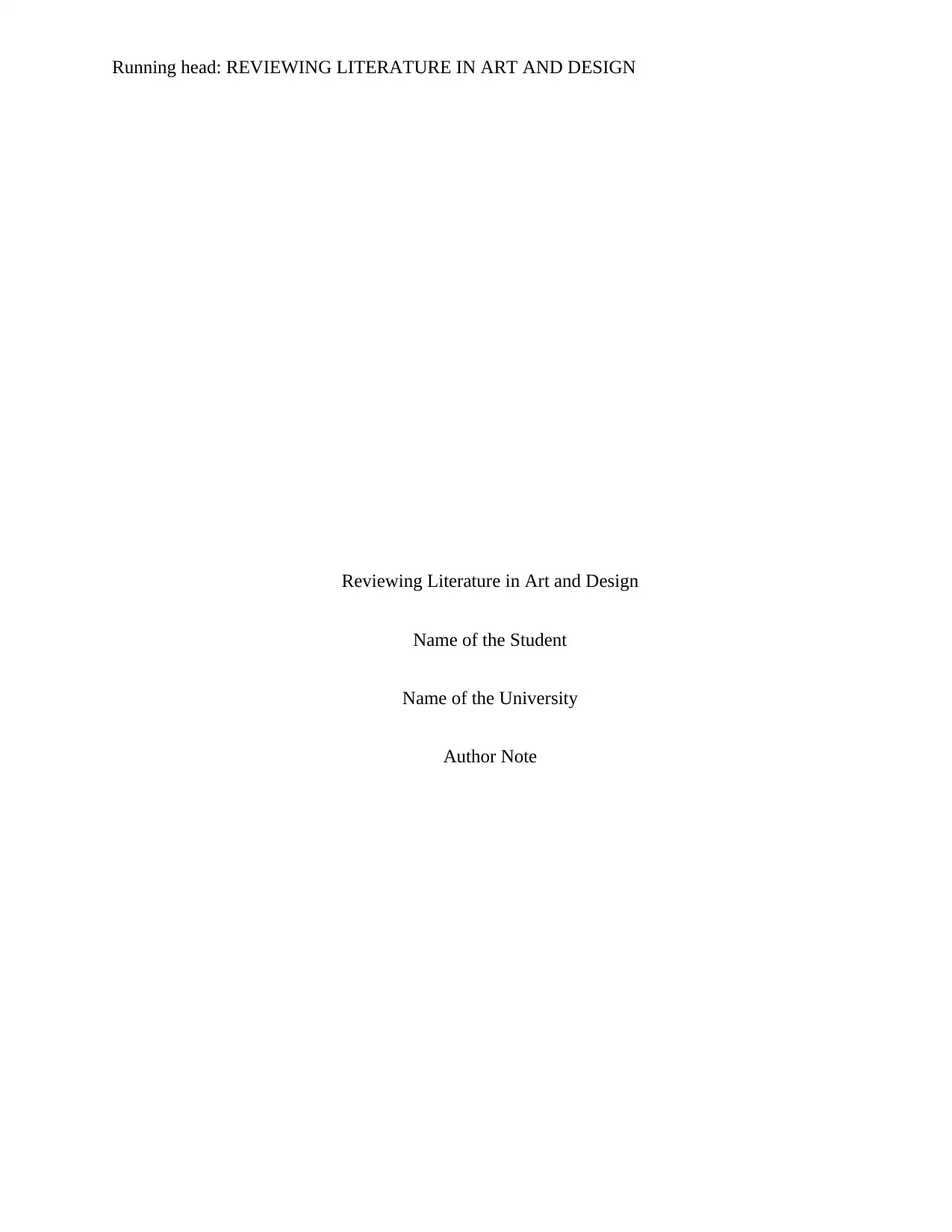
Running head: REVIEWING LITERATURE IN ART AND DESIGN
Reviewing Literature in Art and Design
Name of the Student
Name of the University
Author Note
Reviewing Literature in Art and Design
Name of the Student
Name of the University
Author Note
Secure Best Marks with AI Grader
Need help grading? Try our AI Grader for instant feedback on your assignments.
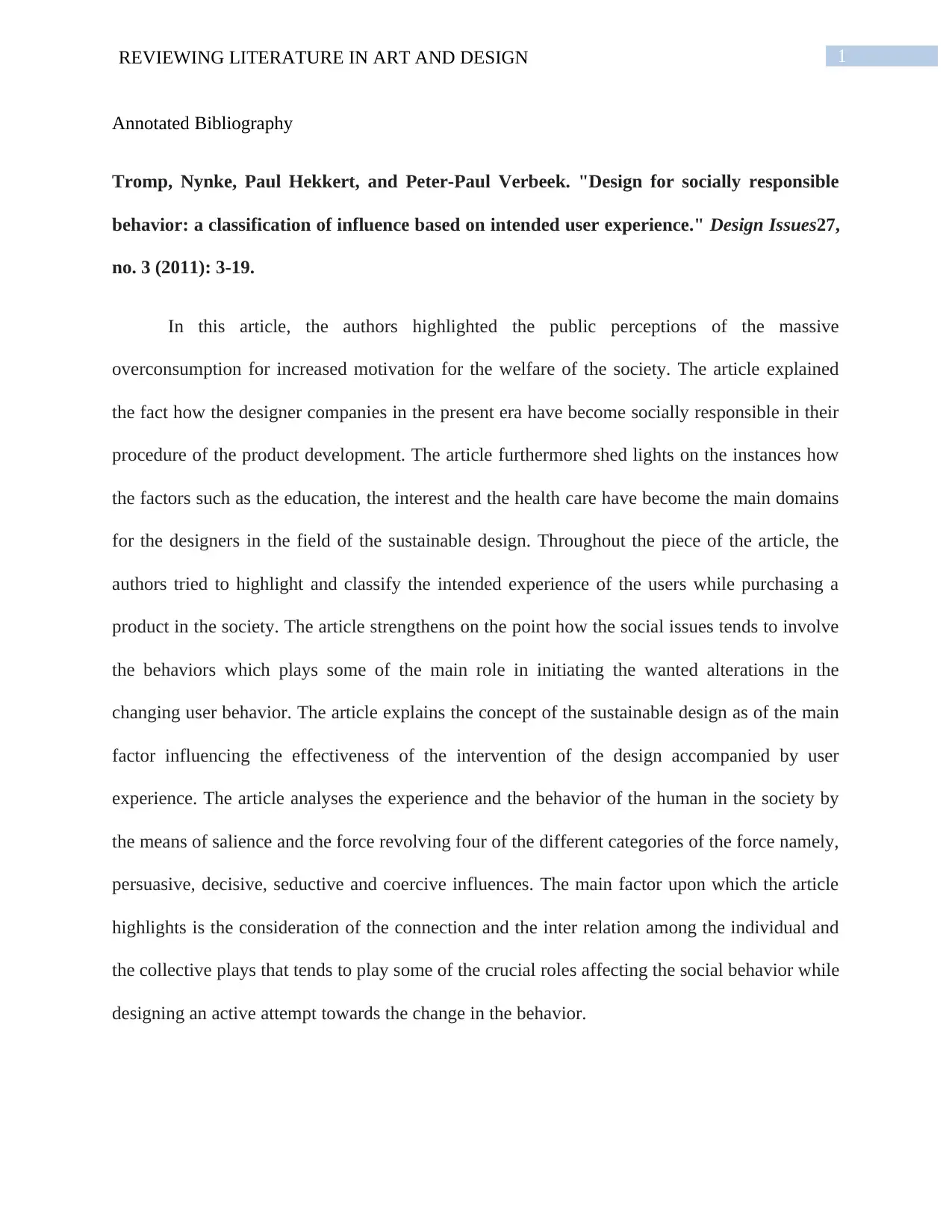
1REVIEWING LITERATURE IN ART AND DESIGN
Annotated Bibliography
Tromp, Nynke, Paul Hekkert, and Peter-Paul Verbeek. "Design for socially responsible
behavior: a classification of influence based on intended user experience." Design Issues27,
no. 3 (2011): 3-19.
In this article, the authors highlighted the public perceptions of the massive
overconsumption for increased motivation for the welfare of the society. The article explained
the fact how the designer companies in the present era have become socially responsible in their
procedure of the product development. The article furthermore shed lights on the instances how
the factors such as the education, the interest and the health care have become the main domains
for the designers in the field of the sustainable design. Throughout the piece of the article, the
authors tried to highlight and classify the intended experience of the users while purchasing a
product in the society. The article strengthens on the point how the social issues tends to involve
the behaviors which plays some of the main role in initiating the wanted alterations in the
changing user behavior. The article explains the concept of the sustainable design as of the main
factor influencing the effectiveness of the intervention of the design accompanied by user
experience. The article analyses the experience and the behavior of the human in the society by
the means of salience and the force revolving four of the different categories of the force namely,
persuasive, decisive, seductive and coercive influences. The main factor upon which the article
highlights is the consideration of the connection and the inter relation among the individual and
the collective plays that tends to play some of the crucial roles affecting the social behavior while
designing an active attempt towards the change in the behavior.
Annotated Bibliography
Tromp, Nynke, Paul Hekkert, and Peter-Paul Verbeek. "Design for socially responsible
behavior: a classification of influence based on intended user experience." Design Issues27,
no. 3 (2011): 3-19.
In this article, the authors highlighted the public perceptions of the massive
overconsumption for increased motivation for the welfare of the society. The article explained
the fact how the designer companies in the present era have become socially responsible in their
procedure of the product development. The article furthermore shed lights on the instances how
the factors such as the education, the interest and the health care have become the main domains
for the designers in the field of the sustainable design. Throughout the piece of the article, the
authors tried to highlight and classify the intended experience of the users while purchasing a
product in the society. The article strengthens on the point how the social issues tends to involve
the behaviors which plays some of the main role in initiating the wanted alterations in the
changing user behavior. The article explains the concept of the sustainable design as of the main
factor influencing the effectiveness of the intervention of the design accompanied by user
experience. The article analyses the experience and the behavior of the human in the society by
the means of salience and the force revolving four of the different categories of the force namely,
persuasive, decisive, seductive and coercive influences. The main factor upon which the article
highlights is the consideration of the connection and the inter relation among the individual and
the collective plays that tends to play some of the crucial roles affecting the social behavior while
designing an active attempt towards the change in the behavior.
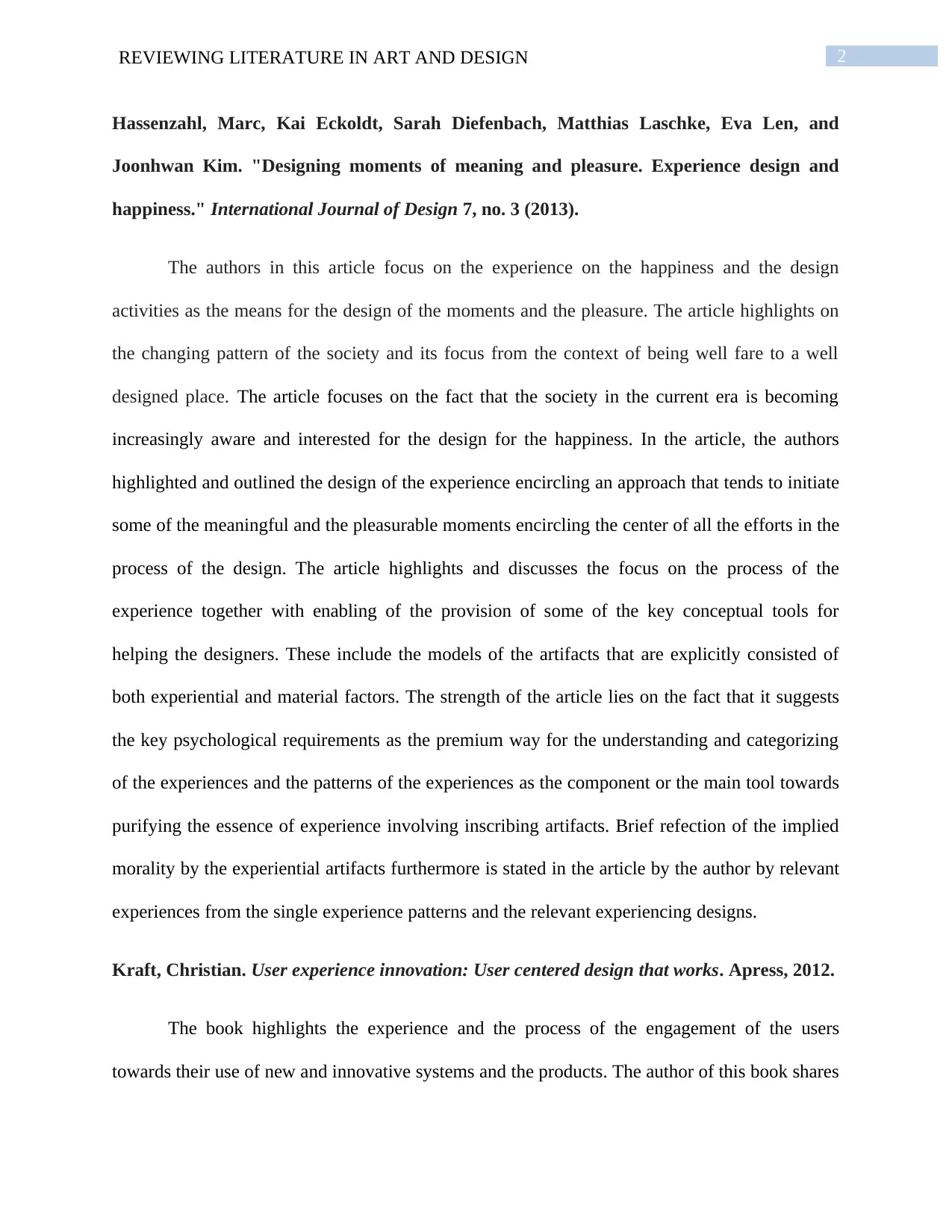
2REVIEWING LITERATURE IN ART AND DESIGN
Hassenzahl, Marc, Kai Eckoldt, Sarah Diefenbach, Matthias Laschke, Eva Len, and
Joonhwan Kim. "Designing moments of meaning and pleasure. Experience design and
happiness." International Journal of Design 7, no. 3 (2013).
The authors in this article focus on the experience on the happiness and the design
activities as the means for the design of the moments and the pleasure. The article highlights on
the changing pattern of the society and its focus from the context of being well fare to a well
designed place. The article focuses on the fact that the society in the current era is becoming
increasingly aware and interested for the design for the happiness. In the article, the authors
highlighted and outlined the design of the experience encircling an approach that tends to initiate
some of the meaningful and the pleasurable moments encircling the center of all the efforts in the
process of the design. The article highlights and discusses the focus on the process of the
experience together with enabling of the provision of some of the key conceptual tools for
helping the designers. These include the models of the artifacts that are explicitly consisted of
both experiential and material factors. The strength of the article lies on the fact that it suggests
the key psychological requirements as the premium way for the understanding and categorizing
of the experiences and the patterns of the experiences as the component or the main tool towards
purifying the essence of experience involving inscribing artifacts. Brief refection of the implied
morality by the experiential artifacts furthermore is stated in the article by the author by relevant
experiences from the single experience patterns and the relevant experiencing designs.
Kraft, Christian. User experience innovation: User centered design that works. Apress, 2012.
The book highlights the experience and the process of the engagement of the users
towards their use of new and innovative systems and the products. The author of this book shares
Hassenzahl, Marc, Kai Eckoldt, Sarah Diefenbach, Matthias Laschke, Eva Len, and
Joonhwan Kim. "Designing moments of meaning and pleasure. Experience design and
happiness." International Journal of Design 7, no. 3 (2013).
The authors in this article focus on the experience on the happiness and the design
activities as the means for the design of the moments and the pleasure. The article highlights on
the changing pattern of the society and its focus from the context of being well fare to a well
designed place. The article focuses on the fact that the society in the current era is becoming
increasingly aware and interested for the design for the happiness. In the article, the authors
highlighted and outlined the design of the experience encircling an approach that tends to initiate
some of the meaningful and the pleasurable moments encircling the center of all the efforts in the
process of the design. The article highlights and discusses the focus on the process of the
experience together with enabling of the provision of some of the key conceptual tools for
helping the designers. These include the models of the artifacts that are explicitly consisted of
both experiential and material factors. The strength of the article lies on the fact that it suggests
the key psychological requirements as the premium way for the understanding and categorizing
of the experiences and the patterns of the experiences as the component or the main tool towards
purifying the essence of experience involving inscribing artifacts. Brief refection of the implied
morality by the experiential artifacts furthermore is stated in the article by the author by relevant
experiences from the single experience patterns and the relevant experiencing designs.
Kraft, Christian. User experience innovation: User centered design that works. Apress, 2012.
The book highlights the experience and the process of the engagement of the users
towards their use of new and innovative systems and the products. The author of this book shares
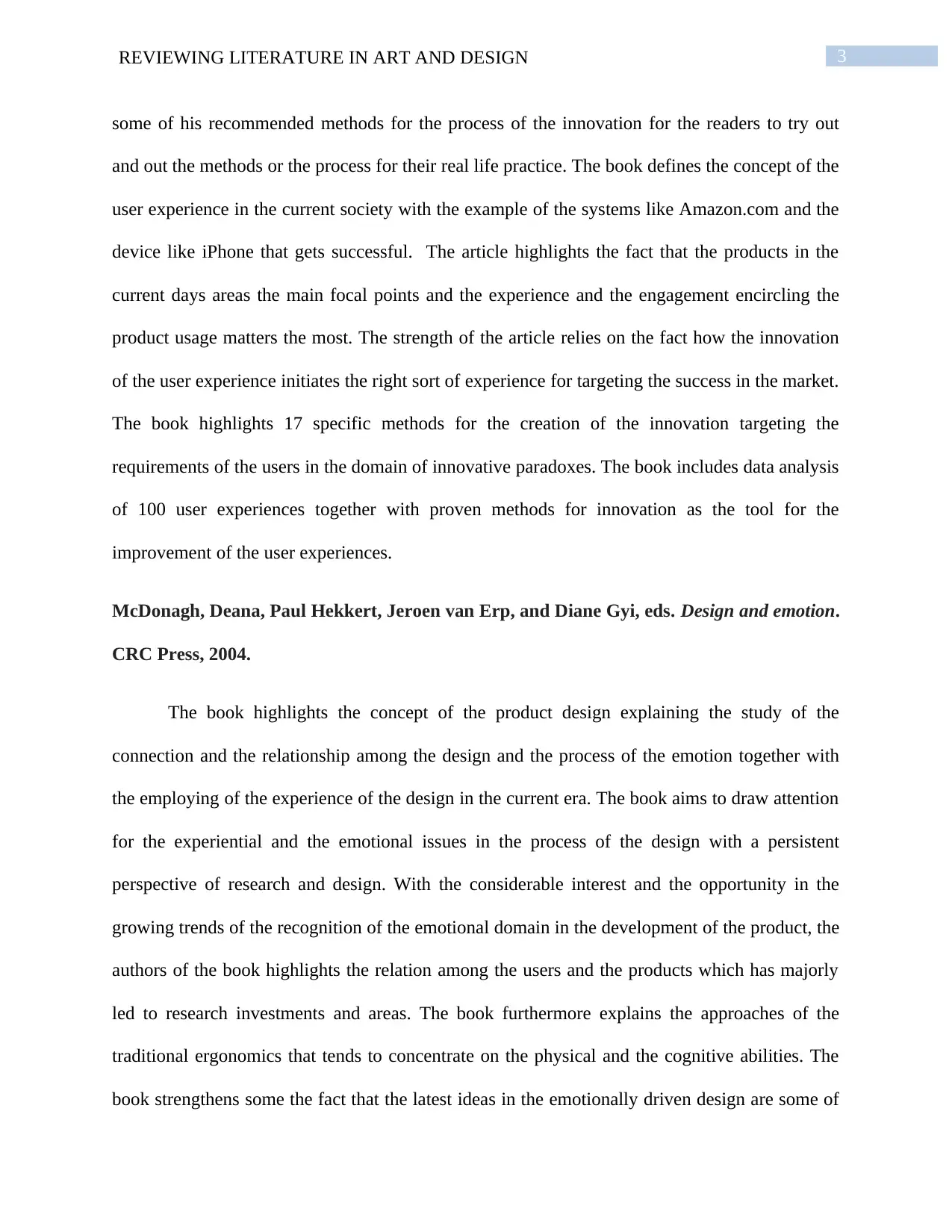
3REVIEWING LITERATURE IN ART AND DESIGN
some of his recommended methods for the process of the innovation for the readers to try out
and out the methods or the process for their real life practice. The book defines the concept of the
user experience in the current society with the example of the systems like Amazon.com and the
device like iPhone that gets successful. The article highlights the fact that the products in the
current days areas the main focal points and the experience and the engagement encircling the
product usage matters the most. The strength of the article relies on the fact how the innovation
of the user experience initiates the right sort of experience for targeting the success in the market.
The book highlights 17 specific methods for the creation of the innovation targeting the
requirements of the users in the domain of innovative paradoxes. The book includes data analysis
of 100 user experiences together with proven methods for innovation as the tool for the
improvement of the user experiences.
McDonagh, Deana, Paul Hekkert, Jeroen van Erp, and Diane Gyi, eds. Design and emotion.
CRC Press, 2004.
The book highlights the concept of the product design explaining the study of the
connection and the relationship among the design and the process of the emotion together with
the employing of the experience of the design in the current era. The book aims to draw attention
for the experiential and the emotional issues in the process of the design with a persistent
perspective of research and design. With the considerable interest and the opportunity in the
growing trends of the recognition of the emotional domain in the development of the product, the
authors of the book highlights the relation among the users and the products which has majorly
led to research investments and areas. The book furthermore explains the approaches of the
traditional ergonomics that tends to concentrate on the physical and the cognitive abilities. The
book strengthens some the fact that the latest ideas in the emotionally driven design are some of
some of his recommended methods for the process of the innovation for the readers to try out
and out the methods or the process for their real life practice. The book defines the concept of the
user experience in the current society with the example of the systems like Amazon.com and the
device like iPhone that gets successful. The article highlights the fact that the products in the
current days areas the main focal points and the experience and the engagement encircling the
product usage matters the most. The strength of the article relies on the fact how the innovation
of the user experience initiates the right sort of experience for targeting the success in the market.
The book highlights 17 specific methods for the creation of the innovation targeting the
requirements of the users in the domain of innovative paradoxes. The book includes data analysis
of 100 user experiences together with proven methods for innovation as the tool for the
improvement of the user experiences.
McDonagh, Deana, Paul Hekkert, Jeroen van Erp, and Diane Gyi, eds. Design and emotion.
CRC Press, 2004.
The book highlights the concept of the product design explaining the study of the
connection and the relationship among the design and the process of the emotion together with
the employing of the experience of the design in the current era. The book aims to draw attention
for the experiential and the emotional issues in the process of the design with a persistent
perspective of research and design. With the considerable interest and the opportunity in the
growing trends of the recognition of the emotional domain in the development of the product, the
authors of the book highlights the relation among the users and the products which has majorly
led to research investments and areas. The book furthermore explains the approaches of the
traditional ergonomics that tends to concentrate on the physical and the cognitive abilities. The
book strengthens some the fact that the latest ideas in the emotionally driven design are some of
Secure Best Marks with AI Grader
Need help grading? Try our AI Grader for instant feedback on your assignments.
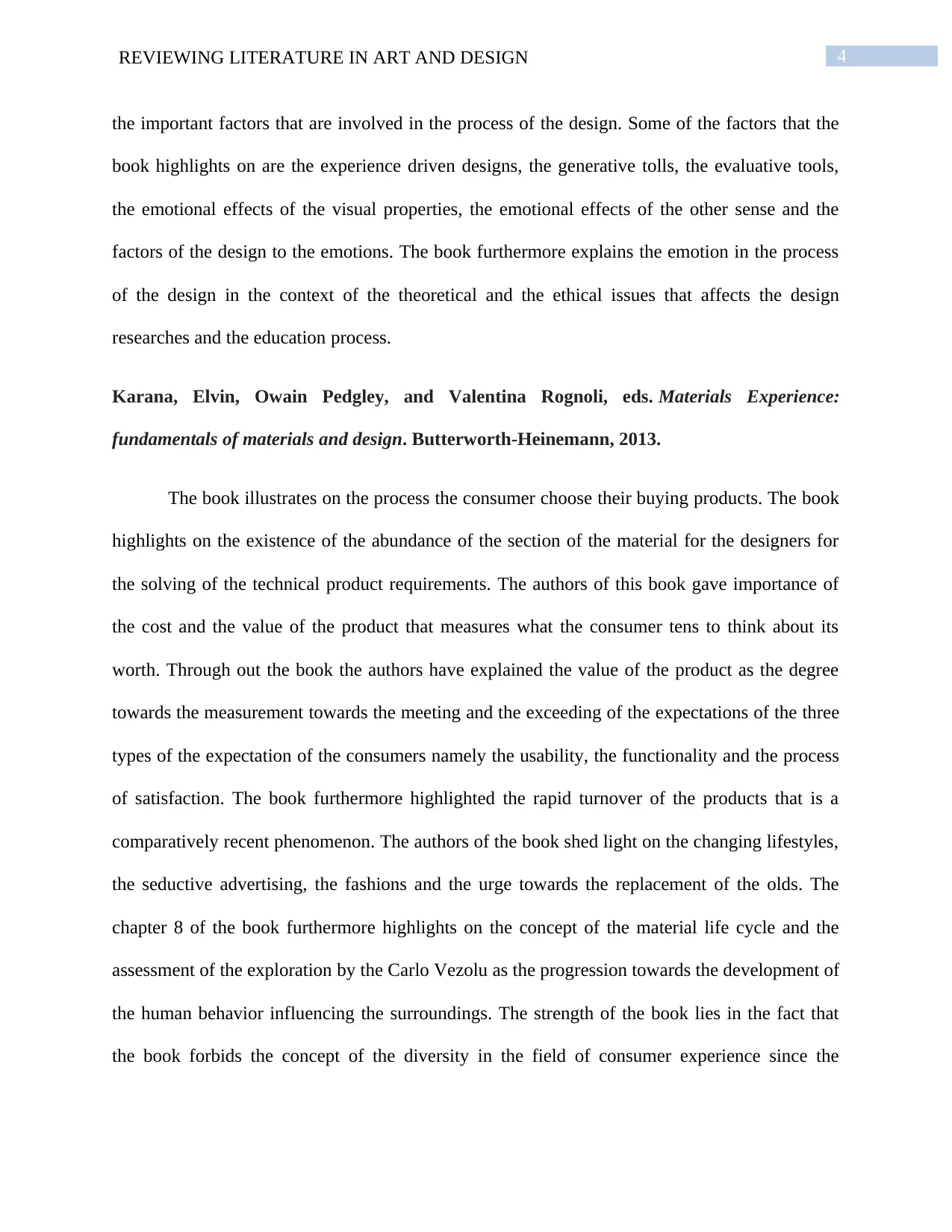
4REVIEWING LITERATURE IN ART AND DESIGN
the important factors that are involved in the process of the design. Some of the factors that the
book highlights on are the experience driven designs, the generative tolls, the evaluative tools,
the emotional effects of the visual properties, the emotional effects of the other sense and the
factors of the design to the emotions. The book furthermore explains the emotion in the process
of the design in the context of the theoretical and the ethical issues that affects the design
researches and the education process.
Karana, Elvin, Owain Pedgley, and Valentina Rognoli, eds. Materials Experience:
fundamentals of materials and design. Butterworth-Heinemann, 2013.
The book illustrates on the process the consumer choose their buying products. The book
highlights on the existence of the abundance of the section of the material for the designers for
the solving of the technical product requirements. The authors of this book gave importance of
the cost and the value of the product that measures what the consumer tens to think about its
worth. Through out the book the authors have explained the value of the product as the degree
towards the measurement towards the meeting and the exceeding of the expectations of the three
types of the expectation of the consumers namely the usability, the functionality and the process
of satisfaction. The book furthermore highlighted the rapid turnover of the products that is a
comparatively recent phenomenon. The authors of the book shed light on the changing lifestyles,
the seductive advertising, the fashions and the urge towards the replacement of the olds. The
chapter 8 of the book furthermore highlights on the concept of the material life cycle and the
assessment of the exploration by the Carlo Vezolu as the progression towards the development of
the human behavior influencing the surroundings. The strength of the book lies in the fact that
the book forbids the concept of the diversity in the field of consumer experience since the
the important factors that are involved in the process of the design. Some of the factors that the
book highlights on are the experience driven designs, the generative tolls, the evaluative tools,
the emotional effects of the visual properties, the emotional effects of the other sense and the
factors of the design to the emotions. The book furthermore explains the emotion in the process
of the design in the context of the theoretical and the ethical issues that affects the design
researches and the education process.
Karana, Elvin, Owain Pedgley, and Valentina Rognoli, eds. Materials Experience:
fundamentals of materials and design. Butterworth-Heinemann, 2013.
The book illustrates on the process the consumer choose their buying products. The book
highlights on the existence of the abundance of the section of the material for the designers for
the solving of the technical product requirements. The authors of this book gave importance of
the cost and the value of the product that measures what the consumer tens to think about its
worth. Through out the book the authors have explained the value of the product as the degree
towards the measurement towards the meeting and the exceeding of the expectations of the three
types of the expectation of the consumers namely the usability, the functionality and the process
of satisfaction. The book furthermore highlighted the rapid turnover of the products that is a
comparatively recent phenomenon. The authors of the book shed light on the changing lifestyles,
the seductive advertising, the fashions and the urge towards the replacement of the olds. The
chapter 8 of the book furthermore highlights on the concept of the material life cycle and the
assessment of the exploration by the Carlo Vezolu as the progression towards the development of
the human behavior influencing the surroundings. The strength of the book lies in the fact that
the book forbids the concept of the diversity in the field of consumer experience since the
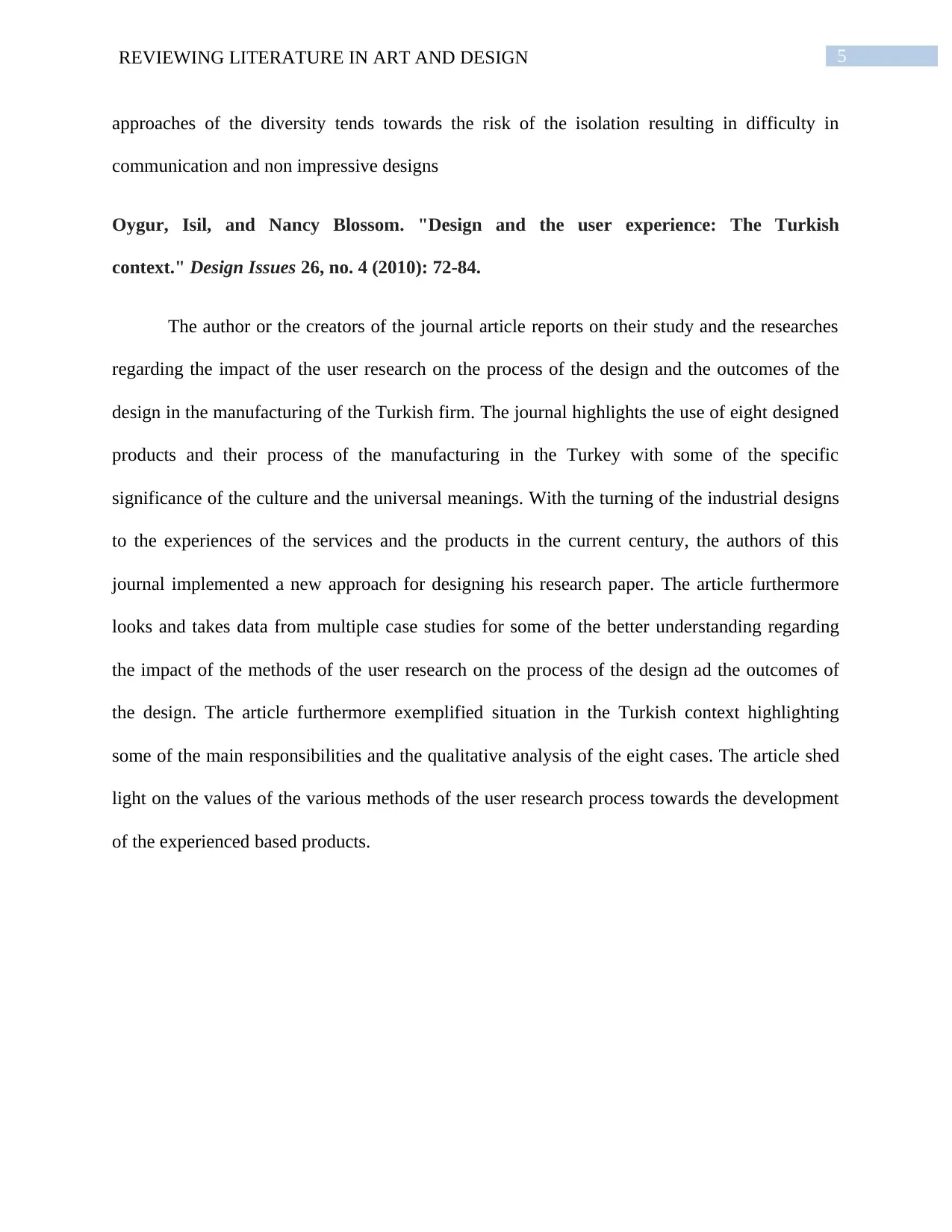
5REVIEWING LITERATURE IN ART AND DESIGN
approaches of the diversity tends towards the risk of the isolation resulting in difficulty in
communication and non impressive designs
Oygur, Isil, and Nancy Blossom. "Design and the user experience: The Turkish
context." Design Issues 26, no. 4 (2010): 72-84.
The author or the creators of the journal article reports on their study and the researches
regarding the impact of the user research on the process of the design and the outcomes of the
design in the manufacturing of the Turkish firm. The journal highlights the use of eight designed
products and their process of the manufacturing in the Turkey with some of the specific
significance of the culture and the universal meanings. With the turning of the industrial designs
to the experiences of the services and the products in the current century, the authors of this
journal implemented a new approach for designing his research paper. The article furthermore
looks and takes data from multiple case studies for some of the better understanding regarding
the impact of the methods of the user research on the process of the design ad the outcomes of
the design. The article furthermore exemplified situation in the Turkish context highlighting
some of the main responsibilities and the qualitative analysis of the eight cases. The article shed
light on the values of the various methods of the user research process towards the development
of the experienced based products.
approaches of the diversity tends towards the risk of the isolation resulting in difficulty in
communication and non impressive designs
Oygur, Isil, and Nancy Blossom. "Design and the user experience: The Turkish
context." Design Issues 26, no. 4 (2010): 72-84.
The author or the creators of the journal article reports on their study and the researches
regarding the impact of the user research on the process of the design and the outcomes of the
design in the manufacturing of the Turkish firm. The journal highlights the use of eight designed
products and their process of the manufacturing in the Turkey with some of the specific
significance of the culture and the universal meanings. With the turning of the industrial designs
to the experiences of the services and the products in the current century, the authors of this
journal implemented a new approach for designing his research paper. The article furthermore
looks and takes data from multiple case studies for some of the better understanding regarding
the impact of the methods of the user research on the process of the design ad the outcomes of
the design. The article furthermore exemplified situation in the Turkish context highlighting
some of the main responsibilities and the qualitative analysis of the eight cases. The article shed
light on the values of the various methods of the user research process towards the development
of the experienced based products.
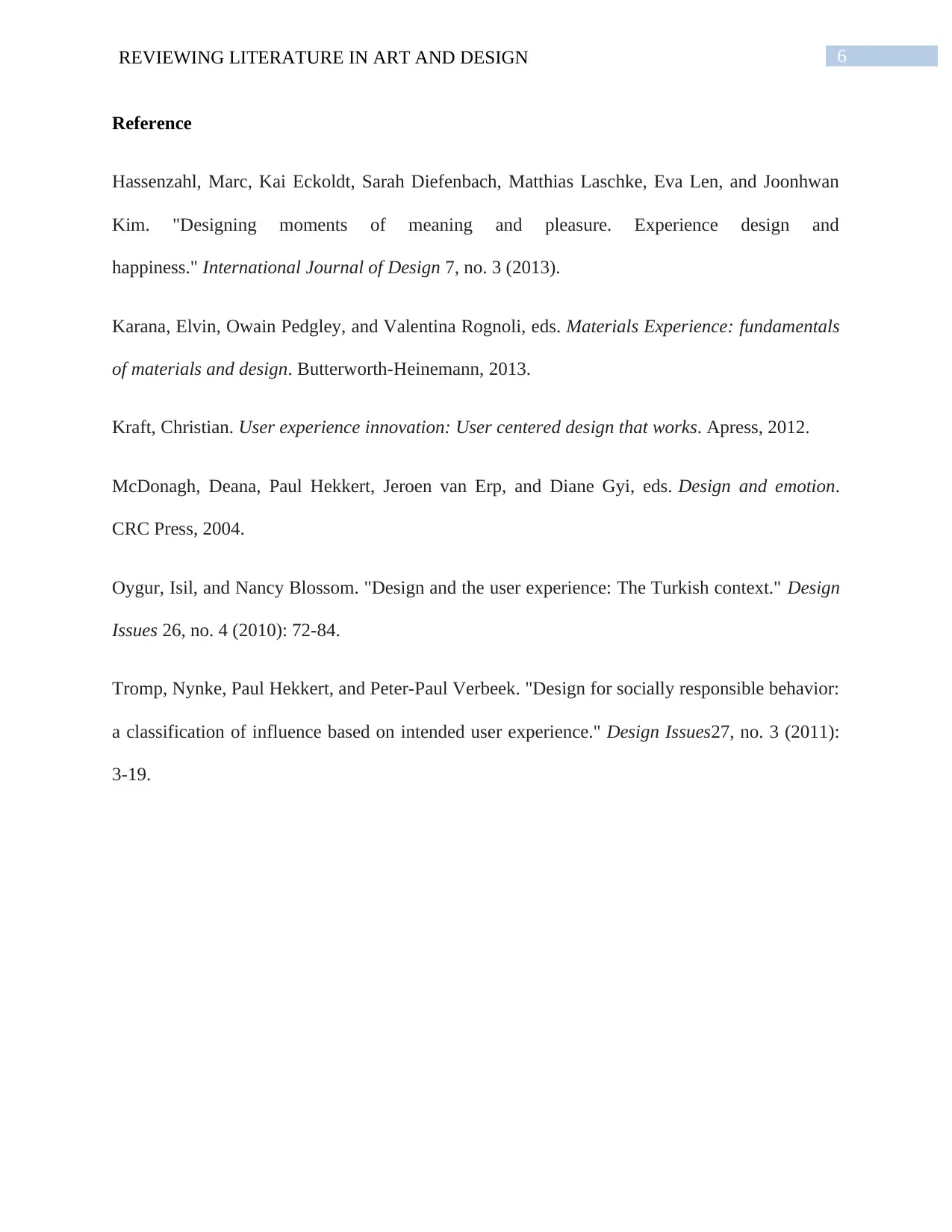
6REVIEWING LITERATURE IN ART AND DESIGN
Reference
Hassenzahl, Marc, Kai Eckoldt, Sarah Diefenbach, Matthias Laschke, Eva Len, and Joonhwan
Kim. "Designing moments of meaning and pleasure. Experience design and
happiness." International Journal of Design 7, no. 3 (2013).
Karana, Elvin, Owain Pedgley, and Valentina Rognoli, eds. Materials Experience: fundamentals
of materials and design. Butterworth-Heinemann, 2013.
Kraft, Christian. User experience innovation: User centered design that works. Apress, 2012.
McDonagh, Deana, Paul Hekkert, Jeroen van Erp, and Diane Gyi, eds. Design and emotion.
CRC Press, 2004.
Oygur, Isil, and Nancy Blossom. "Design and the user experience: The Turkish context." Design
Issues 26, no. 4 (2010): 72-84.
Tromp, Nynke, Paul Hekkert, and Peter-Paul Verbeek. "Design for socially responsible behavior:
a classification of influence based on intended user experience." Design Issues27, no. 3 (2011):
3-19.
Reference
Hassenzahl, Marc, Kai Eckoldt, Sarah Diefenbach, Matthias Laschke, Eva Len, and Joonhwan
Kim. "Designing moments of meaning and pleasure. Experience design and
happiness." International Journal of Design 7, no. 3 (2013).
Karana, Elvin, Owain Pedgley, and Valentina Rognoli, eds. Materials Experience: fundamentals
of materials and design. Butterworth-Heinemann, 2013.
Kraft, Christian. User experience innovation: User centered design that works. Apress, 2012.
McDonagh, Deana, Paul Hekkert, Jeroen van Erp, and Diane Gyi, eds. Design and emotion.
CRC Press, 2004.
Oygur, Isil, and Nancy Blossom. "Design and the user experience: The Turkish context." Design
Issues 26, no. 4 (2010): 72-84.
Tromp, Nynke, Paul Hekkert, and Peter-Paul Verbeek. "Design for socially responsible behavior:
a classification of influence based on intended user experience." Design Issues27, no. 3 (2011):
3-19.
1 out of 7
Related Documents
Your All-in-One AI-Powered Toolkit for Academic Success.
+13062052269
info@desklib.com
Available 24*7 on WhatsApp / Email
![[object Object]](/_next/static/media/star-bottom.7253800d.svg)
Unlock your academic potential
© 2024 | Zucol Services PVT LTD | All rights reserved.



